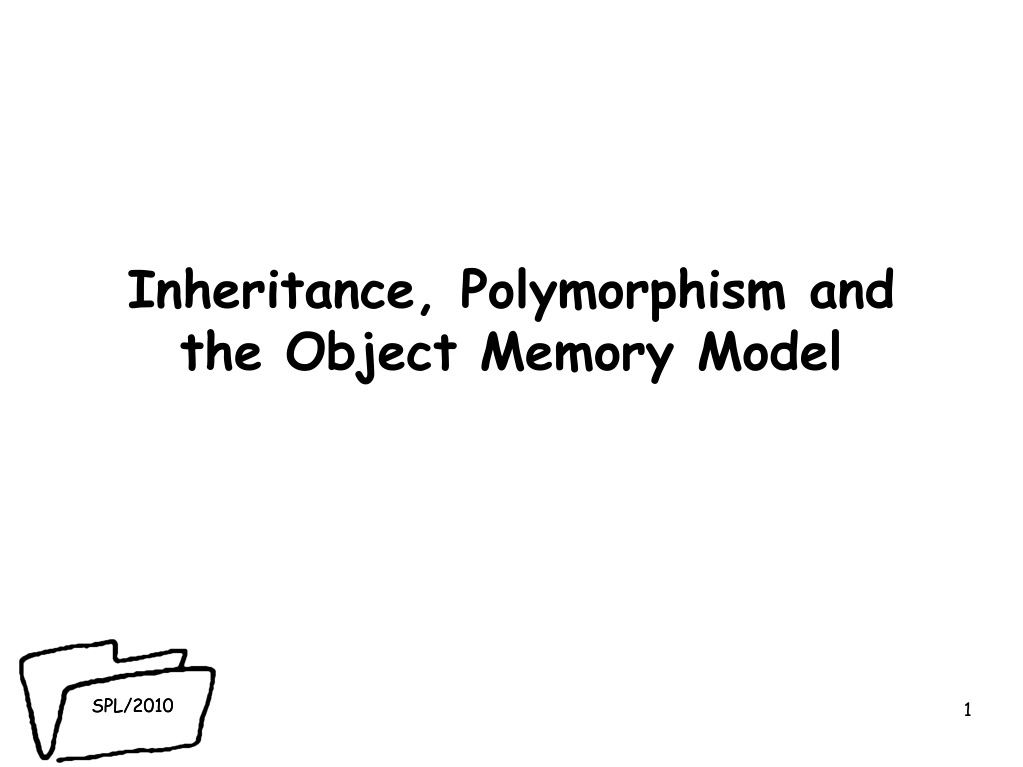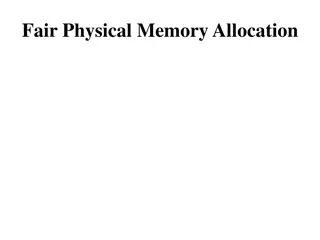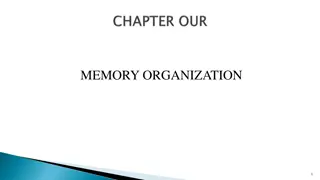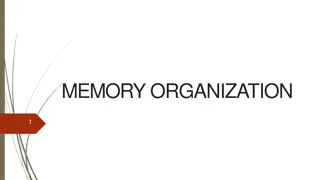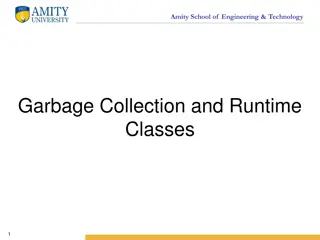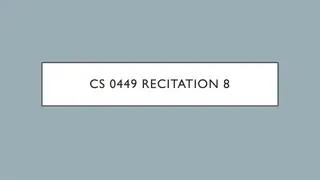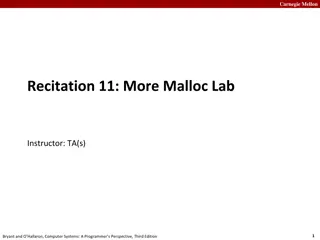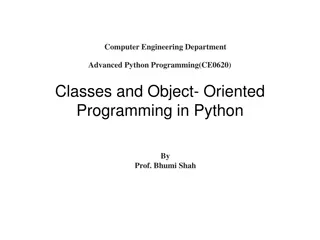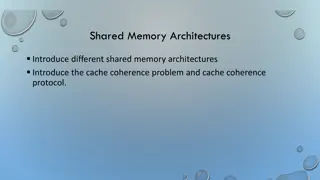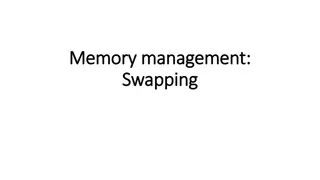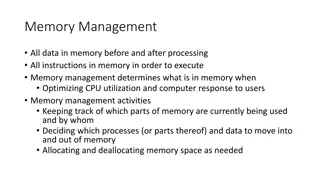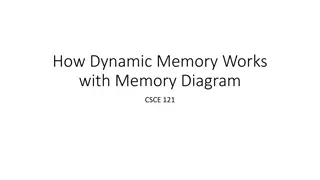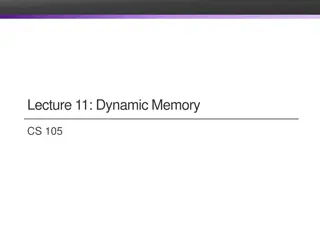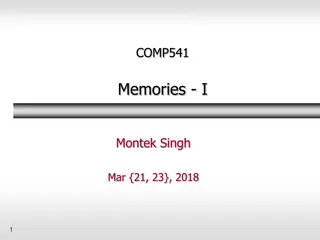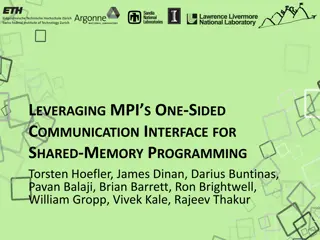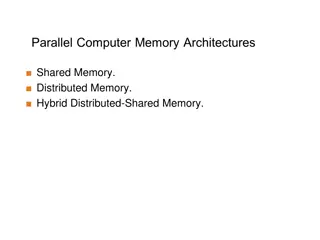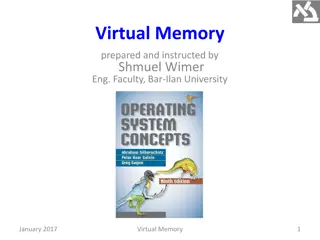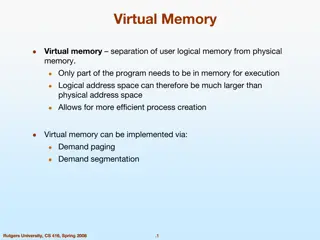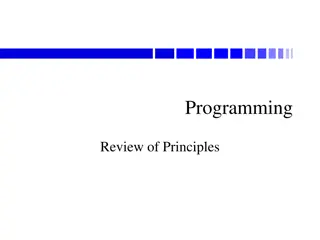Object Memory Management in Programming
Exploring how objects are stored in memory at runtime, this content delves into the concepts of inheritance, polymorphism, and the object memory model. It discusses how objects are implemented in memory, the allocation of class data members, and the storage of object values and references. The text also covers the sizing of primitive types, field alignment, and more.
Download Presentation

Please find below an Image/Link to download the presentation.
The content on the website is provided AS IS for your information and personal use only. It may not be sold, licensed, or shared on other websites without obtaining consent from the author. Download presentation by click this link. If you encounter any issues during the download, it is possible that the publisher has removed the file from their server.
E N D
Presentation Transcript
Inheritance, Polymorphism and the Object Memory Model SPL/2010 SPL/2010 1
how objects are stored in memory at runtime? compiler - operations such as access to a member of an object are compiled runtime - implementation of operations such as new and delete SPL/2010 SPL/2010 2
Object-class in memory object= instance of a class class defines characteristics of instances: data members (state)/member functions (methods). object is implemented at runtime as a region of storage (a contiguous block of memory) class defines the memory layout of all the objects that belong to that class SPL/2010 SPL/2010 3
Object-class in memory object of class is allocated a copy of all class data members static members allocated once objects of class share member functions (methods) code for functions is stored only once in memory for each class. SPL/2010 SPL/2010 4
object values / object references object references is as a pointer to an object value object values are implemented as a contiguous block of memory, where each field (data member) is stored in sequence SPL/2010 SPL/2010 5
SPL/2010 SPL/2010 6
sizeof() primitive type is encoded in a fixed amount of memory. int 4 bytes, char 1 byte, double 8 bytes etc. sizeof() - size used by a given type. computed at compile-time a compiler operator can return size allocated for object data-types sizeof(A) = 20 (5 words of 4 bytes). SPL/2010 SPL/2010 7
Field Alignment fields c1 and c2 are "word aligned" within the block of memory of the object: fields start on a word boundary (word=4b) memory left "wasted" compiler flag not to align fields aligning fields - easy data accessing SPL/2010 SPL/2010 8
Bitfields should be avoided SPL/2010 SPL/2010 9
SPL/2010 SPL/2010 10
reference to a field - compiler uses offset of field within the object a1.c2 is translated to: push activation frame for new block with one variable of 20 bytes (for a1) invoke constructor of A on the address of register S (top of stack) READ [S]+12, B - address [S]+12 into register B SPL/2010 SPL/2010 11
Memory Layout of Arrays field is aligned on a word boundary arrays are generally "packed": elements of array are one after the other no holes char *str = the cat ; SPL/2010 SPL/2010 12
Memory Layout and Inheritance class B extends class A fields defined in A exist in B new fields for objects of type B. block memory for objects of class B is larger than that of objects of class A. SPL/2010 SPL/2010 13
first 20 bytes = structure of type A. "look at a B value as if an "A value": take first part of B and "cut" to sizeof(A). SPL/2010 SPL/2010 14
C++ and memory code for the methods of a class is stored only once for each class picture of the memory allocated to a process covers 3 distinct areas: heap: values allocated using the new operator stack: automatic values in activation frames code segment: code of all the classes used in the program executed by the process SPL/2010 SPL/2010 15
abstract objects & memory model an abstract object is characterized by the following elements: identity state set of objects it knows interface (set of messages to which the object can react) SPL/2010 SPL/2010 16
abstract objects & memory model identity - address of object data in memory state of object - encoded in associated memory block (fields values) interface of object - known by the compiler, based on type of object methods for objects to react (defined by class) SPL/2010 SPL/2010 17
interface: C::C(), C::~C(), C::f(), C::g() SPL/2010 SPL/2010 18
code region method is stored in code region allocated to process in which the class is used method is encoded as sequence of processor instructions method is known to compiler by start address in memory invocation of method = sequence of instructions: parameters pushed on stack method invoked by using CALL instruction of the processor passed the address of the first instruction of the method that is invoked. SPL/2010 SPL/2010 19
push new activation frame on stack - c1= 8B + x=4B invoke C::C() on the address [S] push [S] -- push the address of c1 on the stack push $2 -- push the constant 2 on the stack push [S] -- push the address of c1 on the stack call [C::f] -- invoke c1.f(2) write ReturnRegister [S-4] -- copy the value returned by f into variable x which is below c1 in the stack pop [S] pop the address of c1 from stack call [C::~C] -- invoke the destructor of c1 SPL/2010 SPL/2010 20
compiler maintains internal table where it keeps track of the address of each of the methods of the class compiler invokes a method of a class method has access to internal state of object, wherever it may be. How? SPL/2010 SPL/2010 21
implicit "this" parameter How method knows where are fields of object? Solution: compiler always passes a "hidden" parameter to method call: address of the object-this this of type C* (for class C): address of block organized according to structure of class C. SPL/2010 SPL/2010 22
Static method static methods do not have access to this - can be invoked independently C::static_method(x) SPL/2010 SPL/2010 23
Polymorphism ability to use an operator or function in different ways. Different meanings to the operators or functions (poly = many / morph = shape) 6+5 a + bc 3.2+4.75 SPL/2010 SPL/2010 24
Late Binding Polymorphism = essential property of OO languages Refers to the possibility to decide which method to invoke at runtime and not at compile time. SPL/2010 SPL/2010 25
SPL/2010 SPL/2010 26
s->draw() compiler does not know the address of the function to invoke same C++ instruction will sometimes execute: "call [Circle::draw]" "call [Rectangle::draw]" How does the compiler manage to produce the right code? SPL/2010 SPL/2010 27
Vtable Mechanism compiler delaying the decision of method to invoke to runtime, instead of compile time. method is marked as virtual actual method invoked depends on the type of the value of the object at runtime not on the type of the value at compile time SPL/2010 SPL/2010 28
s is a variable of type Shape invoke s->draw(): Call draw() of Rectangle or Circle by value to which s is bound at time of invocation SPL/2010 SPL/2010 29
virtual-table (vtable) how an object decides which code to invoke when it receives a message? message = invocation of a method through a pointer to an object. value of object in memory is extended by a pointer to a table with function address table is stored explicitly in process memory (code region). table for each class that contains virtual methods. SPL/2010 SPL/2010 30
vtable for class foo SPL/2010 SPL/2010 31
Invoking a virtual method Suppose d is of type foo *. call to object reference: d->m(): dereferencing d's vpointer, looking up the m entry in the vtable, dereferencing that pointer to call the correct method code. SPL/2010 SPL/2010 32
Example: *((*d)[2])(d); Assume vpointer is always the first element in d: d is the address of the beginning of the block of memory which stores the foo value bound to d *d is the content of the first word in the block of memory: it contains the address of the vtable (*d)[2] is the address of the 3rd element in the vtable (the address of method m) *((*d)[2])(d) - invoke function located at third slot in vtable of foo and pass to it the address of the value SPL/2010 SPL/2010 33
Inheritance and vtable When a class extends another class, how is the vtable managed? bar extends foo. bar overrides m, and introduces 2 new methods s and t. SPL/2010 SPL/2010 34
compiler generates a new distinct vtable for class bar. vtable elements point: to same addresses as parent when method is not overridden overridden methods or to the new methods otherwise vtable of inherited class is an extension of the vtable of the parent table: shared methods appear in the same order new methods in the child class appear at the end of the vtable. SPL/2010 SPL/2010 35
Vtable and Multiple Inheritance multiple inheritance: a class can extend more than one base class SPL/2010 SPL/2010 36
Multiple Inheritance Class student inherits both from class person and from class gp_list_node vtable layout becomes more complex in such a situation. SPL/2010 SPL/2010 37
Multiple Inheritance object of type student has in its state 3 types of fields (inherited from person, gp_list_node) and declared in class student 3 types of methods (inherited from person, gp_list_node) and defined in class student SPL/2010 SPL/2010 38
Vtable vtable points to student specific vtable vtable first contains person methods, next methods that appear in class student vtable is then followed by the person fields. (look at a student value as a person value - just ignore the bottom part of the block) we cannot store the gp_list_node vtable at the beginning of the block. SPL/2010 SPL/2010 39
So where can we store gp_list_node vtable? Store fields right after the person fields. Store gp_list_node data members after this vtable Finally we store the student specific data members at the end of the data block SPL/2010 SPL/2010 40
SPL/2010 SPL/2010 41
how does the compiler find the appropriate vtable? how to pass valid this pointer to a method of gp_list_node that is not overridden? code cannot know that what it receives as a this pointer is not a real gp_list_node. accesses the fields of the value it has assuming it is a gp_list_node value. SPL/2010 SPL/2010 42
pointer fixup compiler knows what type of method is invoked - either inherited from person, gp_list_node or specific to student. If inherited from gp_list_node: pass "corrected address" (this+d, d=sizeof(person)). look down from this address, block memory looks as a valid gp_list_node value vtable to which we point is also a valid gp_list_node vtable SPL/2010 SPL/2010 43
Casting and Addresses when we cast an object to a different class, we may end up with a different address in memory casting is not only to tell the compiler "trust me I know what I do"; it also can end up generating code to fix the pointers in memory. SPL/2010 SPL/2010 44
SPL/2010 SPL/2010 45
Implicit conversion: short a=2000; int b; b=a; automatically performed when a value is copied to a compatible type Explicit conversion short a=2000; int b; b = (int) a; explicit type-casting allows to convert any pointer into any other pointer type SPL/2010 SPL/2010 46
Dynamic_cast: can be used only with pointers and references ensure that the result of the type conversion is a valid complete object always successful when we cast a class to one of its base classes Compatibility: dynamic_cast requires the Run-Time Type Information (RTTI) to keep track of dynamic types SPL/2010 SPL/2010 47
g++ fdump -class-hierarchy option look at the exact structure of the vtables the compiler generates for us g++ has an option that allows us to get this information in a readable manner: g++ c.cpp -fdump-class-hierarchy -o c generates a text file called c.cpp.t01.class which gives the details of the memory layout and vtable of the classes defined in the file. SPL/2010 SPL/2010 48
SPL/2010 SPL/2010 49
SPL/2010 SPL/2010 50
